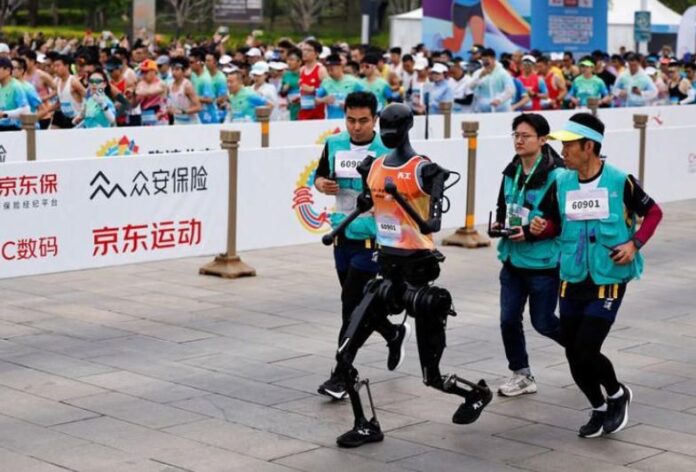Beijing made history on Saturday as the world’s first human vs. humanoid half-marathon concluded, with humans and robots racing side by side along a challenging 13-mile course. The event, a fusion of athletic competition and technological innovation, showcased the potential of endurance robotics while solidifying Beijing’s status as a burgeoning “AI town.”
The race saw two-legged humanoid robots, ranging from 0.5 to 2 meters in height, compete under strict rules—no wheels or unfair advantages were allowed. The robots faced significant challenges, completing 250,000 joint movements, battling wind gusts, managing unstable signals, and performing battery swaps, which incurred 10-minute penalties. Human runners, meanwhile, tackled the same course, creating a unique man-versus-machine spectacle.
Watch Video
Ready, set, go! The world’s first #humanoid robot #half-marathon kicked off at Beijing E-Town on Saturday. Aside from the Finisher’s Medal, a total of 20 teams with their 18 types of robot athletes will compete for the championship title on the 21.0975-km track, as well as… pic.twitter.com/EvpmQhSZiu
— Global Times (@globaltimesnews) April 18, 2025
The course presents unique challenges for the humanoid competitors, who must execute 250,000 joint movements, navigate wind gusts, manage unstable signals, and handle battery swaps, which incur a 10-minute penalty. These obstacles are designed to push the limits of robotic endurance, offering a glimpse into the future of robotics in real-world scenarios.
Beijing’s $686 million investment in AI infrastructure, which includes plans to deploy 10,000 robots, underscores the city’s commitment to becoming a global leader in artificial intelligence. The half-marathon serves as a high-profile platform to showcase these advancements, blending innovation with athletic competition.
The world's first half-marathon featuring both humans and robots has kicked off in Beijing's E-Town! More than 9,000 amateur runners are sharing the 21.0975-kilometer course with humanoid robots from nearly 20 robotics companies. #SeeingisBelieving pic.twitter.com/X6gtcSkJ9H
— CGTN (@CGTNOfficial) April 19, 2025
Prizes for the event range from $418 to $697, but the true reward lies in the data and insights gained from testing robotic capabilities in such a demanding environment. Organizers hope the race will not only captivate audiences but also accelerate the development of endurance robotics, paving the way for future applications in industries ranging from logistics to disaster response. As humans and machines race side by side, Beijing is positioning itself at the forefront of the AI revolution, one step—or stride—at a time.

Key Points: World’s First Human vs. Humanoid Half-Marathon in Beijing
- Historic Race: Beijing hosts the first-ever human vs. humanoid half-marathon on Saturday, covering a 13-mile course.
- Robot Challenges: Humanoid robots must perform 250,000 joint movements, handle wind gusts, manage battery swaps (with 10-minute penalties), and overcome unstable signals.
- Eligibility Rules: Only two-legged robots between 0.5 and 2 meters are allowed; no wheels permitted.
- Beijing’s AI Ambition: The race aligns with Beijing’s goal to become an “AI town,” backed by $686 million in funding and plans for 10,000 robots.
- Prizes and Purpose: Winners will earn $418 to $697, but the primary goal is to test and advance endurance robotics technology.
- Future Implications: The event aims to drive innovation in robotics for applications like logistics and disaster response.



